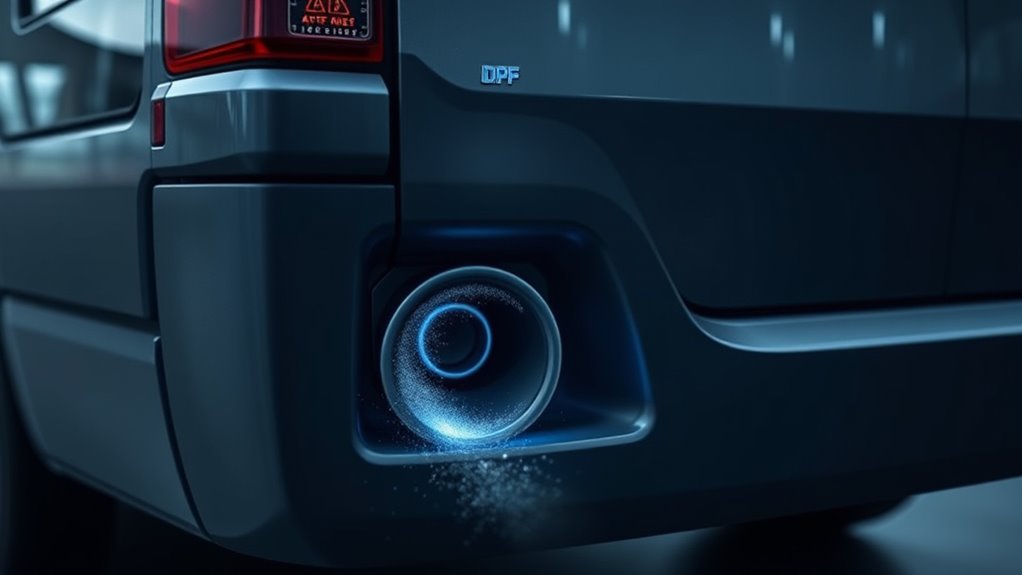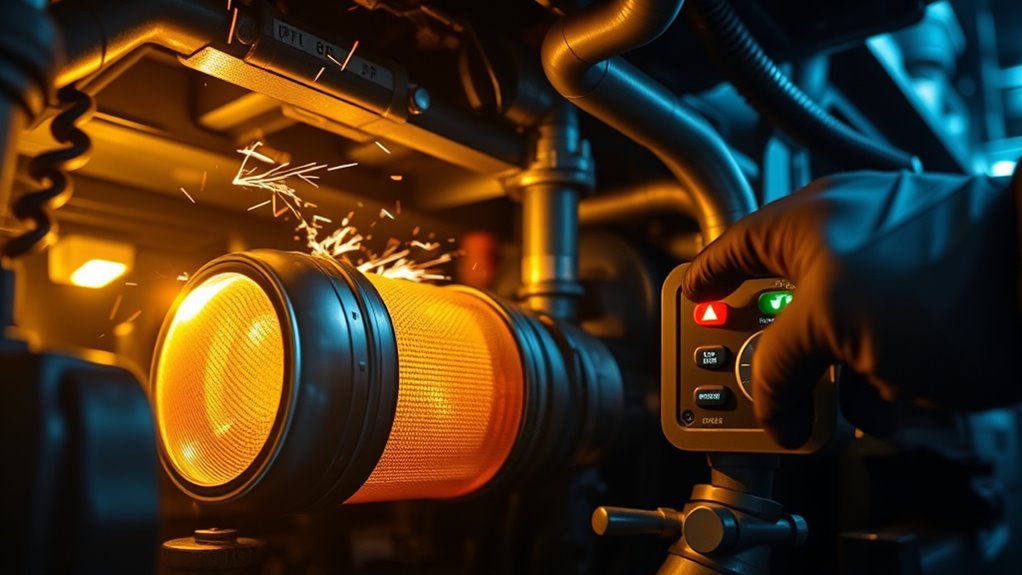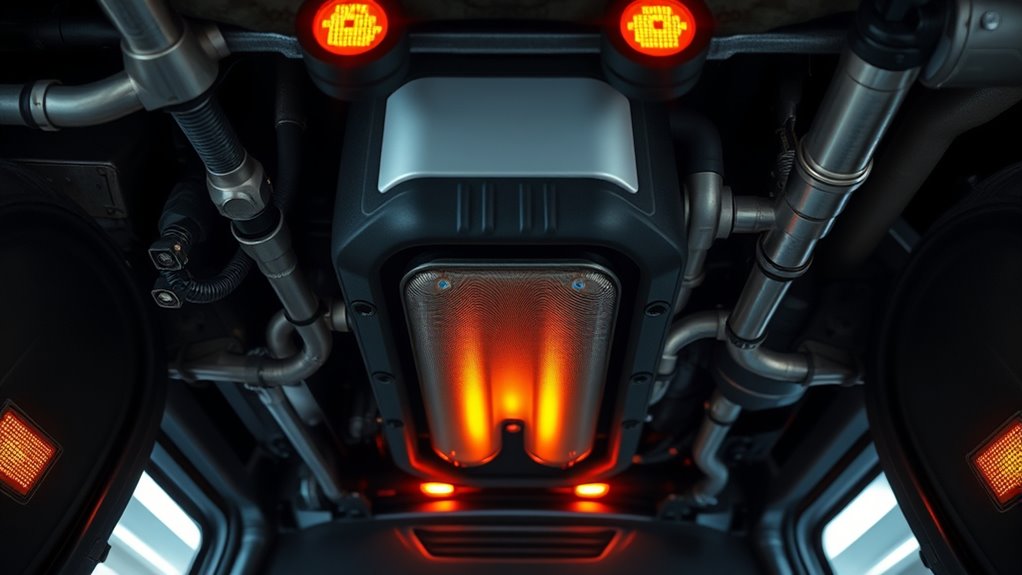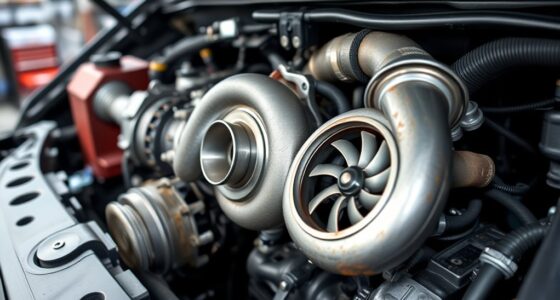Your transit diesel’s Diesel Particulate Filter (DPF) captures up to 95% of soot and needs regular regeneration to stay effective. This process burns off accumulated soot at high temperatures, which can happen passively or actively, sometimes prompted by warning lights. If you see dash warnings, don’t ignore them—follow protocols to initiate manual regeneration if necessary. Understanding how temperature, driving patterns, and alerts work will help you keep your vehicle running smoothly and extend its lifespan.
Key Takeaways
- DPF regeneration converts accumulated soot into CO₂, typically triggered when soot levels reach a threshold.
- Passive regeneration occurs automatically during normal driving at high exhaust temperatures.
- Active regeneration is initiated by the vehicle’s system through extra fuel injection when needed.
- Low-speed, stop-and-go driving can hinder regeneration, risking clogging and increased maintenance.
- Warning indicators or dashboard alerts notify drivers of DPF status or regeneration needs to prevent damage.
Understanding the Role of the Diesel Particulate Filter in Transit Vehicles

The Diesel Particulate Filter (DPF) plays an essential role in reducing emissions from transit diesel vehicles by capturing harmful soot particles before they exit the exhaust. It acts like a high-tech trap, using cellular ceramic honeycomb filters made of materials such as cordierite or silicon carbide that resist heat. The DPF can trap up to 95% of soot and particulate matter, considerably lowering emissions to meet EPA and Euro 5 standards. Since 2007, installing DPFs has been mandatory in most diesel transit vehicles to combat air pollution. By capturing fine black carbon particles and nanoparticles, the DPF prevents black smoke and harmful particulates from polluting the air. It also helps maintain engine efficiency and prolongs engine life, which further supports the vehicle’s performance and durability. Understanding the technology behind the DPF helps vehicle operators better appreciate its importance. This helps protect public health and ensures your vehicle remains compliant with environmental regulations.
The Regeneration Process: Turning Soot Into Emissions-Free Exhaust

Regeneration is the essential process that transforms trapped soot in the DPF into less harmful emissions by burning it off through high-temperature oxidation. When exhaust gas reaches around 600°C (1112°F), the soot is ignited and combusted into carbon dioxide (CO2) and water vapor. This process occurs either passively, during normal driving, or actively, when extra fuel injection raises exhaust temps to trigger soot oxidation. Sensors measure pressure differences across the filter to monitor soot buildup, starting active regeneration when needed. Catalysts inside the DPF help lower the temperature required for combustion, making the process more efficient. As a result, up to 90% of particulates are burned off, restoring filter capacity and ensuring cleaner emissions while maintaining engine performance. Understanding of the regeneration process can help vehicle owners recognize its importance in maintaining engine health and emission standards. Additionally, advancements in filter technology continue to improve regeneration efficiency and durability.
How Operating Conditions Influence Regeneration Cycles

Your driving conditions directly impact how often and effectively your DPF regenerates. Low-speed and stop-and-go patterns cause cooler exhaust temperatures, making passive regeneration harder and increasing active cycle frequency. Advanced temperature management techniques can help maintain ideal exhaust heat, ensuring cleaner and more efficient regeneration under challenging operating conditions. Proper engine tuning and maintenance are also crucial for optimizing exhaust temperatures and supporting effective DPF regeneration. Additionally, understanding various toilet types and features can improve your overall bathroom experience. Implementing advanced temperature management techniques can also help mitigate issues caused by inconsistent driving patterns and promote more consistent DPF regeneration, especially when considering engine performance optimization to ensure effective heat management.
Low-Speed Regeneration Triggers
Operating conditions at low speeds substantially influence DPF regeneration cycles, often preventing the exhaust temperatures needed for passive cleaning. When you drive below 50 km/h, the engine doesn’t generate enough heat to burn off soot passively, leading to increased soot buildup. To compensate, the ECU triggers active regeneration, injecting extra fuel to raise exhaust temperatures above 600°C. However, frequent low-speed trips can delay or interrupt regeneration, causing soot to accumulate faster. If the soot level reaches a critical point, the system may log fault codes like P242F and activate warning lights. Prolonged low-speed driving without long, high-speed runs prevents complete regeneration cycles, risking DPF clogging. Engine temperature drops at low speeds, reducing the effectiveness of regeneration processes. Maintaining proper exhaust temperature is essential for the DPF to burn off soot effectively, especially during transit operations. Additionally, operating under specific driving conditions significantly impacts the frequency and success of regeneration cycles. To maintain ideal performance, you need periodic high-speed driving or forced regenerations, especially in transit vehicles operating mainly at low speeds. Additionally, understanding how operating conditions influence regeneration cycles can help prevent costly repairs and ensure optimal vehicle performance.
Stop-and-Go Driving Effects
Stop-and-go traffic repeatedly interrupts active DPF regeneration cycles, making it difficult for the system to complete soot burn-off. Frequent stops lower exhaust temperatures, which are essential for maintaining the heat needed to burn off accumulated soot. As a result, regeneration efforts are often cut short, leading to partial cleaning and residual soot buildup that can clog the filter over time. The engine control unit (ECU) tries to start regeneration but often resets during idling or low-speed conditions common in stop-and-go driving. This cycle increases the frequency of forced regenerations, raising engine stress and fuel use. Over time, these interruptions accelerate DPF and engine wear, negatively impacting vehicle longevity and emissions compliance. Proper driving conditions are crucial to ensure efficient, complete regeneration. Additionally, inadequate driving patterns can cause the DPF to become progressively clogged, further impairing performance and increasing repair costs. It is also important to understand that creative problem-solving can help develop better driving habits to prevent these issues and extend the lifespan of the DPF. Incorporating proper driving techniques can significantly improve regeneration efficiency by maintaining optimal exhaust temperatures and preventing filter clogging.
Advanced Temperature Management
Exhaust temperature plays a critical role in the effectiveness of DPF regeneration, especially under varying operating conditions. To burn off soot effectively, exhaust temperatures need to reach around 1100°F (600°C). The Diesel Oxidation Catalyst (DOC) inlet must hit 600°F to 800°F (315°C to 425°C) to start dosing fuel for regeneration. When exhaust temps rise above 550°C, active regeneration begins, oxidizing accumulated soot. During low load or idling, exhaust heat drops, risking incomplete regeneration and filter clogging. Thermal management strategies, such as fuel injection or electric heating, help maintain necessary temperatures. Some systems use burners or proprietary algorithms to monitor soot load and control heat input. Proper temperature management ensures optimal performance and *prevents damage*, maintaining filter performance across diverse operating conditions. Implementing temperature sensors and real-time monitoring can enhance system reliability and efficiency.
Recognizing and Responding to Dash-Mounted Warnings

Recognizing dash-mounted warnings related to the DPF system is essential for maintaining vehicle health and emissions compliance. The warning lights indicate whether the filter is clogged or malfunctioning. A steady light signals the need for passive regeneration, while a flashing light means urgent action is required. Ignoring these warnings can cause engine damage or failure. Common icons are orange or yellow and shaped like a filter or engine. Use the table below to interpret warning behaviors: | Warning Type | Meaning | Recommended Response | |———————|——————————-|———————————-| | Solid light | Early clog or malfunction | Drive at highway speeds 15-30 min | | Flashing light | Critical clog or fault | Immediate service or diagnose | | Color Indicators | Severity level | Follow specific vehicle instructions | | Additional Signs | Reduced performance, fuel use | Do not ignore, seek diagnostics | Additionally, understanding the regeneration process can help prevent severe issues and ensure the DPF functions correctly. Being aware of local laws and regulations concerning emissions can also guide timely maintenance actions. Regular monitoring of warning lights and following proper maintenance protocols are vital for optimal vehicle operation.
Manual Regeneration: When and How to Safely Perform It

Performing a manual DPF regeneration safely requires guaranteeing specific preconditions are met to prevent damage and ensure effectiveness. First, ensure your engine is at normal operating temperature, as cold starts can hinder soot burning. Your fuel tank should be at least one-quarter full to supply enough energy during regeneration. Check your vehicle manual for manufacturer-specific procedures, and confirm you’ve driven enough to cause soot buildup, such as through short trips. Use a compatible diagnostic tool, like an OBD2 scanner, connected to the OBD port under the dashboard. Select the DPF regeneration function and follow prompts, keeping the vehicle stationary in a well-ventilated area. Never initiate regeneration if warning lights indicate unresolved issues, and avoid shutting off the engine mid-cycle to prevent damage. Additionally, be aware of bank swift codes that may be relevant when arranging professional service or support. Regularly monitoring your vehicle’s emissions control system can help identify issues before they require manual regeneration. Understanding AI-driven advancements in vehicle diagnostics may further enhance your ability to maintain optimal emissions systems.
Maintenance Strategies for Optimal DPF Performance

Maintaining your DPF’s performance requires a proactive approach to regular inspection and monitoring. Schedule inspections every 3 to 6 months to catch soot and ash buildup early. Use onboard diagnostics and monitor fuel efficiency and exhaust noise; drops or unusual sounds signal potential issues. Check for oil leaks or injector wear, which can increase soot. Keep engine operation within recommended parameters and ensure the duty cycle remains consistent. Use quality consumables like low-ash oils and high-quality diesel fuel, avoiding harmful additives. Regular professional cleaning removes ash deposits that regeneration can’t eliminate. Ultimately, maintain a steady driving pattern—preferably highway driving—to promote passive regeneration. Proper engine management is essential for optimal DPF performance and longevity. Additionally, understanding the role of factors influencing soot accumulation can help you implement more effective maintenance practices.
Technological Advances Improving Regeneration Efficiency

Advances in catalyst formulation, like durable metal oxide coatings, boost the longevity and effectiveness of regeneration systems. Predictive soot estimation tools help you anticipate when regeneration is needed, reducing unnecessary cycles and fuel use. Integrating these innovations with engine management systems guarantees precise control, maximizing efficiency and minimizing emissions during regeneration. Innovative sensor technologies are also being incorporated to provide real-time feedback on filter status, further enhancing regeneration accuracy and reliability.
Catalyst Formulation Innovations
Innovations in catalyst formulation are crucial for enhancing DPF regeneration efficiency, as they optimize the materials and loadings to promote faster soot oxidation at lower temperatures. By adjusting platinum (Pt) loading to around 1.32 g and incorporating metals like CuO, La₂O₃, MgO, and Y₂O₃, you can improve oxidation and thermal stability while reducing NO₂ emissions by up to 40%. High BET surface area coatings enhance soot combustion and heat resistance. These advances enable efficient low-temperature operation, prolonging filter life and reducing thermal shocks.
| Catalyst Components | Benefits |
|---|---|
| Pt, Pd, Base Metals | Enhanced activity, stability |
| Metal Loadings | Lower emissions, better oxidation |
| Coatings | Improved heat resistance, surface area |
Predictive Soot Estimation
Predictive soot estimation has become essential for optimizing DPF regeneration, as it allows systems to accurately determine soot and ash levels in real time. By continuously analyzing sensor data—such as pressure drop, temperature, engine speed, load, and particulate matter concentration—you can get a precise picture of soot load inside the filter. These models consider ash accumulation, adjusting regeneration thresholds to prevent premature or delayed cycles, thereby enhancing efficiency and prolonging filter life. They also account for uneven soot and ash distribution caused by temperature gradients, improving accuracy. Combining multiple sensor signals through data fusion and filtering reduces noise and transient effects. Ultimately, predictive soot estimation enables smarter, more reliable regeneration control, reducing fuel consumption and emissions while ensuring optimal filter performance.
Engine Management Integration
Engine management systems have become essential in enhancing DPF regeneration efficiency by integrating a variety of sensors and control strategies. They use data from exhaust gas temperature sensors, pressure sensors, and flow rate sensors to determine the ideal timing for regeneration. This real-time information helps the ECU decide when to trigger active regeneration, such as increasing fuel injection to raise exhaust temp above 600°C, preventing soot buildup. Additionally, these systems combine passive and active strategies, reducing fuel-intensive cycles. Key advances include turbocharging, EGR, and proprietary algorithms that calculate soot load and adjust regeneration timing dynamically. Temperature management tools, like secondary air injection, further optimize conditions. These integrated technologies ensure effective soot removal while maintaining engine performance and meeting strict emission standards. Advanced control algorithms enable more precise and efficient regeneration processes by continuously analyzing sensor data and adapting to driving conditions.
Common Challenges and Tips for Transit Operators

Managing DPF regeneration on transit diesel buses presents several common challenges that can impact operational efficiency. Frequent regeneration events disrupt routes, cause downtime, and increase roadside breakdowns, especially in older engines lacking advanced tech. Forced or manual regenerations add stress to maintenance teams and raise safety risks if mishandled. Training technicians on troubleshooting and handling regen failures is essential but resource-intensive. Fuel quality, particularly low sulfur diesel, influences regen success, while engine modifications for emissions standards complicate the process. Operationally, regen cycles can delay service and reduce fuel economy, especially when scheduled during off-peak hours. Using real-time telematics and proactive diagnostics helps prevent failures. Incorporating features like “Stay Warm” can minimize regen frequency, boosting efficiency and reducing maintenance needs.
Frequently Asked Questions
How Does Ash Buildup Affect DPF Lifespan and Performance?
Ash buildup shortens your DPF lifespan and hampers performance. It causes increased backpressure, forcing your engine to work harder, raising fuel consumption, and leading to more frequent regenerations. Over time, ash hardens and sinters, clogging the filter and reducing its ability to trap soot effectively. Without proper maintenance or cleaning, ash accumulation can lead to filter failure, costly repairs, and a significant reduction in your vehicle’s efficiency and longevity.
Can Regeneration Occur During Vehicle Operation Without Driver Intervention?
A stitch in time saves nine, and the same applies here. You don’t need to intervene for regeneration to occur during vehicle operation. Your vehicle’s ECU automatically manages passive, enhanced passive, and active regenerations when conditions are right, like high exhaust temperatures. These processes happen seamlessly, ensuring your DPF stays clear without driver input. Just keep driving normally, and the system will handle soot build-up for you.
What Are the Environmental Impacts of Incomplete or Forced Regenerations?
Incomplete or forced regenerations worsen air quality by releasing higher ultrafine particle emissions that can penetrate deep into your lungs. They also increase black carbon in the atmosphere, contributing to climate warming. These cycles consume more fuel, raising your vehicle’s carbon footprint. Additionally, they pose health risks, especially for communities near transit routes, by exposing residents to toxic emissions. Proper regeneration minimizes these impacts, protecting both the environment and public health.
How Do Climate Conditions Influence the Frequency and Effectiveness of DPF Regeneration?
Think of climate as the weather’s mood swings that influence your DPF’s dance. Cold temperatures act like a frosty spell, slowing exhaust heat and making regeneration harder, like trying to light a fire in the snow. Warm weather fuels quicker, cleaner burns. In winter, you’ll face more frequent active regenerations, increasing fuel use and emissions, while hot summers let your DPF breathe easier and regenerate more effectively.
Are There Specific Vehicle Models More Prone to DPF Issues in Transit Applications?
Some vehicle models are more prone to DPF issues in transit applications, particularly the 2018 Ford Transit 3.2L diesel. You might notice frequent clogging and regeneration warnings due to design flaws like blocked vaporizers and insufficient exhaust temperatures. These models often struggle with passive regeneration, especially during stop-and-go city driving. If you own or operate such vehicles, stay vigilant with diagnostics and consider maintenance or updates to prevent costly repairs.
Conclusion
Think of your DPF as a vigilant guardian, silently working behind the scenes to keep your transit vehicle clean. When you understand its regeneration process and heed warning signs, you’re guiding it smoothly through its daily battle against soot. With proper maintenance and timely interventions, you prevent costly repairs and keep the engine running like a well-oiled machine. Together, you and your DPF form a powerful team, ensuring cleaner air and reliable transit every day.









